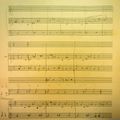Science Serves the Arts
Delia's papers include her score dated 5th July 1962[1]for Science Serves the Arts, a science series for 6th formers produced by Lawrie Lawler.[2]
We don't know if this was a theme music for all the programmes, or a special insert for the first programme about Science and Music. By a strange coincidence, the programme interviews Tristram Cary as a renowned electronic music composer and someone Delia would meet five years later at Unit Delta Plus.
From the manuscript, the piece is a strange mixture of 3/4 and 4/4 bars, while along the top of page 1 appears the most hackneyed chord sequence in Western popular music, the "Blues" sequence C-C-F-C-G-F-C-C.
Contents
Episodes
As listed in the Radio Times:[2]
1: Science and Music
Among the multitude of new scientific developments artists are finding many which help them in their work. JOHN BORWICK discusses with TRISTRAM CARY the use a modern composer makes of electronic equipment to increase his range of sounds and whether he is influenced by modern recording techniques.
2: The Anatomy of Painting
Many modern art galleries have their own laboratories. Here scientific techniques are used to probe beneath the surface of old paintings and rediscover the methods and materials used by the masters of the past.
MICHAEL HECKFORD shows some examples of these techniques and explains how a modern artist uses the technical advances of his own times to help him broaden the scope of his work.
3: Translation By Machine
Modern communications are turning the world into a Tower of Babel, and yet few people speak more than one language. DONALD BOOTH describes how science is trying to help not only the translator but those research workers engaged in analysing great writings of the past.
4: The Paper Problem
As the world becomes educated an avalanche of printed paper is engulfing libraries. Donald Booth shows how the new National Lending Library is tackling the problem.
5: Revealing the Past
The art of the historian is based on analysing the evidence from manuscripts, relics, and archaeological sites. This analysis is now helped by new scientific techniques. BRIAN HOPE-TAYLOR chooses the Anglo-Saxon period to illustrate some of. them.
Papers
DD161321: Manuscript score, side 1
DD161337: Manuscript score, side 2
DD161356: Manuscript score, side 3
DD161422: Manuscript score, side 4
Availability
- First broadcast from 14th January to 18th February 1963 and repeated in 1964 and 1965.[2]
- Getty Images may have copies of the five episodes.



